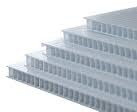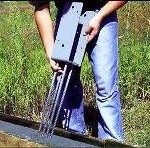Welcome to part three of our three part series on determining the most effective building weather resistant barriers.
Let’s take a look at the best weather resistant barrier choices:
BETTER CHOICES
While the textured housewraps listed above do a good job of keeping water off the sheathing and from entering the house, if you want more protection, install a rainscreen under the wall cladding. Rainscreens are typically installed as vertical strips that are fastened to the wall to which the siding is fastened. The thickness of the strips holds the siding away from the housewrap and the sheathing underneath.
When you install a separate rainscreen, you can first cover the sheathing with any housewrap that passes your water and tear tests; it’s not necessary to use one of the textured wraps discussed above. I’ve also used taped Zip Wall sheathing with a rainscreen.
There are lots of different materials you can use to form a rainscreen, including 1×3 solid wood strapping, or ripped strips ofHardiePlank for walls covered with that product.
 My favorite rainscreen material is Coroplast, a two-layer recycled-plastic sheet product that’s sold in 4×8-foot sheets and used mainly by sign makers and print shops. The outer layers of the product are held apart by parallel flutes that give the material thickness and rigidity. The flutes are continuous along the product’s 8-foot length. Coroplast is available in various thicknesses; for rainscreens, I use 3/8-inch-thick Coroplast.
My favorite rainscreen material is Coroplast, a two-layer recycled-plastic sheet product that’s sold in 4×8-foot sheets and used mainly by sign makers and print shops. The outer layers of the product are held apart by parallel flutes that give the material thickness and rigidity. The flutes are continuous along the product’s 8-foot length. Coroplast is available in various thicknesses; for rainscreens, I use 3/8-inch-thick Coroplast.
The material is easy to rip into strips on a table saw, though I buy it from my sign supplier already cut into 2-inch strips.
For the top and bottom of a wall, we use other, 3-inch-wide strips with the flutes running vertically, which allows convective ventilation behind the siding at the top of the wall and water drainage at the bottom of the wall. Before installing the top and bottom strips, we staple on an 8-inch-wide strip of insect screening, then fold it back over the Coroplast to keep out bugs.
You can also use Coroplast as a rainscreen for vertical siding by attaching the strips horizontally. You’ll need to rip the Coroplast sheets across their 4-foot width and attach them so the flutes run vertically to allow water to drain through them.
For houses with a reservoir cladding—that is, stucco, stone, brick, or any cementitious product that is going to soak up lots of water—I use a zero-perm product, Delta-Dry Stucco & Stone. It’s a 3/8-inch-thick dimpled plastic mat that’s stapled to the housewrap. The exterior side of the product has a built-in mortar screen that prevents scratch coats from filling the dimples. The beauty of Delta-Dry is that it provides an air gap on both sides—between it and the stucco and between it and the sheathing.
BEST CHOICES
For the ultimate protection on walls, there is another category of WRB systems that includes fluid-applied membranes and peel-and-stick membranes. Unlike some other WRBs, these products have the added benefit of air-sealing a wall, as well as protecting it from moisture. Both should be used in conjunction with an installed rainscreen.
I’ve been very impressed with a German peel-and-stick product, Delta-Vent SA that we recently used on a house. There is a fair amount of labor involved in the installation: The sheathing is first covered with a paint-on primer. Then the 3-foot-wide material is unrolled on the wall; once it’s in position, you pull off the backing paper and smooth it into place. A double-stick layer at the edges creates an airtight seal at all the overlapping seams. There are also proprietary tapes for flashing windows and wall openings.
Another peel-and-stick WRB product we’ve used is Aluma Flash—a laminated rubberized-asphalt product. The rubberized-asphalt layer is 40 mils thick and laminated to two layers of polyethylene film, with a top protective layer of aluminum. The aluminum outer layer helps this product withstand UV rays almost indefinitely. It’s applied similarly to Delta-Vent SA.
We have also used fluid-applied flashing and seam-sealing products from Tyvek. They work extremely well for tricky inset window installations. You squirt them on from a caulking gun, then use a trowel or brush to spread the materials, which have the consistency of thick paint. Once cured, they form a rubbery, airtight and watertight bond.
We have not yet used any fluid-applied products to completely cover the walls of a house, but some of the products that look promising are Tremco’s ExoAir 230, Tyvek Fluid Applied WB, and Grace’s Perm-A-Barrier Liquid.
Fluid-applied WRBs are elastomeric products that can be sprayed, rolled, and even brushed on a wall. Depending on the product, some joint and seam filling or priming may be needed first. The cured products form an elastic, airtight, vapor-permeable, and waterproof covering that will stretch and contract a bit as a building moves.
Residential-grade fluid-applied products are thinner, however, than commercial-grade products, which range in thickness from 30 to 75 mils. At that thickness, the material is almost squishy when cured and provides something of a gasketing effect around fasteners for brick ties and the like. My current preference at this point would be to specify one of the commercial products.
DURABILITY TESTING
I recently visited the University of Texas at Austin Construction Durability Lab to see its ongoing testing of WRBs. Mocked-up wall panels were covered in a variety of WRBs, as per manufacturers’ specifications, then left out in the weather, where they’ve been for almost two years now.
As would be expected, the tar-paper-covered panel has not fared well, whereas the thicker, commercial-grade fluid-applied WRBs have performed the best. The thinner, residential-grade fluid-applied WRBs are no better than elastomeric paint, and do not perform very well. I’ve written about the tests on my blog at mattrisinger.com, and I’ll continue to post about them as more test results come in.










I don’t fully understand the vertical rain screen strips. Can you please explain further how they help? From what I understand, these strips keep the siding from directly touching the housewrap? What does this accomplish and why is it necessary? Is it just to create as much airflow and airpockets as possible to allow moisture to dry?
I’ve never used them personally and feel a well done siding application should negate having to use them. With this in mind, how many siding applications are done well?
The actual point is the assumption rain will get through the siding and this leaves a space for moisture to flow out the bottom.